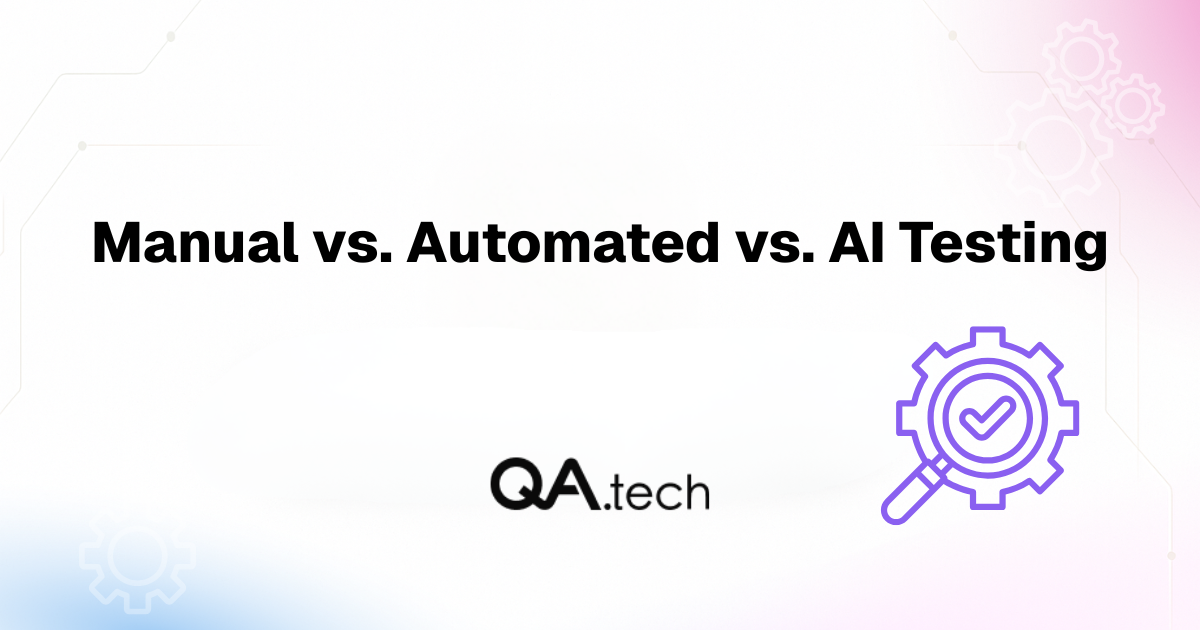Manual vs. Automated vs. AI Testing: Choosing the Right Approach for Your Project


Clear-cut categorization in the context of testing is almost impossible, especially since no tester has refrained from using manual, automated, or nowadays even AI-driven techniques at some point in their work.
Still, when choosing the approach that fits your needs best, you need to keep in mind that they all come with their own sets of strengths and weaknesses. Knowing how and when to use each on a given project may be a challenge, but it can make all the difference in successful testing.
Let’s explore them first.
Manual Testing
No matter the field (whether it’s performance testing, API testing, security testing, or database scripting), manual work is crucial at some point in the workflow. And how could it not be? After all, the goal is not to remove humans from the loop entirely but to minimize the manual work in order to optimize, speed up, and, most importantly, scale the testing workflow.
Manual testing entails more than just systematically clicking through test scenarios. Rather, this process utilizes a member of the testing body whose contribution will bring in real-world perspective and creativity to the scenario: a resource that is difficult (if not impossible) to replicate through automation.
During the development stage of the product life cycle, the organization stands to benefit from manual testing the most. The features are new, and the specifications are still evolving at this point. A real human who has put their hands on the product for the first time will help you identify problems that an automated testing script is most probably not going to detect.
When it comes to usability testing, if you rely solely on automated interactions for the purpose of getting feedback, the entire process loses its value and is reduced to a mindless mechanical task. As a result, the valuable insights that come from genuine human feedback will be stripped away. Real user interaction at this stage helps identify potential confusion points and other problematic areas that impact the user journey.
Unlike automated test scripts, which follow predefined paths, human testers are able to think outside the box by probing for edge cases and coming up with overlooked scenarios. Such an investigative approach adds depth to the testing process that automation alone cannot provide.
Automation Testing
Automation testing comes in handy when the required changes are minimal. In fact, the need of automation first emerged when QAs had to test the same code/feature with every release.
Most of the time, those pieces of code weren’t impacted by the new feature at all. Still, since we’re talking about core features here, they had to be tested to insure an uninterrupted experience for users.
In addition, automation is particularly useful in scenarios that involve high-volume data, stress testing, load testing, and similar. When done manually, this tasks are rather monotonous, which may, in turn, lead to errors. Plus, automated scripts can run thousands of test variations in the time it would take a human tester to complete just a few.
Once the features are no longer being changed, requirements have stabilized, and releases are more frequent, automation becomes the backbone of the testing process. Tasks such as cross-browser checks, API response validations, integration testing, and performance benchmarks become sustainable only through automated execution. With the help of CI/CD pipelines, many scenarios (login, home page, basic checkouts, payment methods) get executed in parallel, which then contributes to rapid delivery.
While automation can’t completely replace manual efforts and creativity, it can surely make the system more consistent and disciplined across various versions and browsers. Still, only the human mind can anticipate how a feature may break; no code can do this on its own, it’s the tester who has to write the scenarios.
AI-Driven Testing
AI pushes the boundaries of QA beyond what traditional manual and automated testing can achieve. Faster execution is only one aspect of it, though. The real value lies in its ability to make informed decisions by anticipating risks, learning from data, and adjusting test coverage based on what matters the most.
Unlike with scripted automation, AI-based testing systems are able to prioritize and produce test cases that target the product's most vulnerable areas through an analysis user behavior patterns, defect history, and system performance.
💡
QA.tech helps companies achieve 10x more with their AI agents that run and write tests on behalf of their QA team.
This stage of product life is particularly challenging, due to high complexity, requirements that change rapidly, and test environments that involve numerous integrations, devices, and user personas. Self-healing scripts, visual validation, and AI-powered test generation lessen the maintenance load, which has long been an issue in automation frameworks.
AI can simulate a wide range of user interactions in usability and customer experience scenarios, including those involving various devices, languages, geographies, and accessibility requirements. Moreover, it can do it at a scale that is impossible for a human tester or conventional automation suite to match. This shift transforms testing from reactive validation to proactive quality assurance due to AI's capacity to identify anomalies and anticipate potential points of failure.
However, AIs true power becomes apparent only when it’s paired with structured manual and automated testing. Namely, it enhances human exploratory abilities with deeper insights and improves automation through self-learning capabilities. This way, it helps businesses move from quality assurance as a stopgap to quality engineering as an ongoing and flexible process.
Determining the Optimal Testing Approach
The most effective QA practice is often a hybrid approach, which carefully combines all three methods and optimizes their value based on the requirements of the project. The true art of quality assurance lies in balancing the strengths and limitations of each technique throughout the product life cycle.
Here’s what we need to consider when combining projects:
- Project complexity: Automation and AI work best in highly complex projects. AI enhances automation's scalability and stability, as it provides adaptive coverage and intelligent risk-based prioritization.
- Uncertainty level: Manual testing is particularly valuable in early or unstable stages where requirements change often. It lets testers investigate evolving functionality without wasting their time on developing automation for features that might change.
- Project size: AI increases the effectiveness of test creation and maintenance. At the same time, automation is necessary to preserve regression coverage in large-scale projects with multiple modules and extended schedules. In contrast, smaller, shorter-term projects might rely on manual testing more.
- Budget: Manual testing guarantees coverage for projects with a tight budget, as it doesn’t require significant upfront costs. Even though AI may be selectively applied to optimize critical or high-maintenance paths, automation can eventually be expanded in those areas of the project where it delivers measurable returns.
- Risk profile: High-risk applications, such as those in finance, healthcare, and aviation, can benefit from combining manual exploratory/negative testing for edge cases with automation for critical regression flows. While automated scripts efficiently handle repetitive compliance checks, manual testing guarantees stronger security and more thorough audit validation.
- Time-to-market pressure: In order to accelerate release cycles, projects with short timelines should combine automation in regression, smoke, and sanity checks with manual exploratory testing (for prompt feedback).
Comparison: Manual vs. Automation vs. AI Testing
Practical Advice for Testing
Nothing can replace a tester's first-hand experience with the product, especially when a new feature is introduced or requirements are unclear. Until they are well-defined and fixed, you can’t expect the code to do anything.
Manual testing is not just a point of entry, though. It is a continuous thread that runs through the entire product lifecycle. It reveals unexpected behaviors, edge cases, and usability problems that automation and AI-based prediction cannot foresee.
Automation should be introduced only after the groundwork has been established. As mentioned, it can be used for the simplest and most repetitive processes; for instance, it’s a good fit for key paths like login, homepage navigation, profile pages, and cancellations. If a regression suite is established for these essential operations, the foundation of the system will continue to be dependable with each release cycle.
For example, a straightforward Selenium script can be used to automate login across various browsers:
WebDriver driver = new ChromeDriver();
driver.get("https://travel-booking-platform.com/login");
driver.findElement([By.id](http://by.id/)("username")).sendKeys("testUser");
driver.findElement([By.id](http://by.id/)("password")).sendKeys("securePass123");
driver.findElement([By.id](http://by.id/)("loginBtn")).click();
// Assert login success
Assert.assertTrue(driver.findElement([By.id](http://by.id/)("welcomeMsg")).isDisplayed());
driver.quit();Not only does this type of automation save time, but it also guarantees that crucial functionality never malfunctions during frequent release cycles. Automation can be expanded to cover more scenarios as features stabilize and the likelihood of frequent changes declines.
AI gives this process a completely new dimension. While automation provides consistency, AI adds intelligence and adaptability. At the same time, it enables teams to concentrate human effort where it is most needed by automatically creating test cases, anticipating risk areas, and optimizing test coverage based on user behavior or defect history.
AI is also capable of creating dynamic datasets, such as random traveler profiles with varying ages, currencies, and loyalty plans.
import random
def generate_passenger():
ages = [5, 18, 30, 45, 70]
currencies = ["USD", "EUR", "INR", "JPY"]
return {
"name": f"TestUser{random.randint(1000,9999)}",
"age": random.choice(ages),
"currency": random.choice(currencies),
"loyaltyPoints": random.randint(0, 5000)
}
#Generate sample passengers
for i in range(3):
print(generate_passenger())The system can test combinations that a human tester might overlook and that an automation suite might not cover, like booking for an elderly person using loyalty points in a multi-currency transaction.
AI is also a good asset in terms of maintenance, which has repeatedly been a problem with automation. Self-healing scripts reduce test flakiness, as they allow locators to adjust when UI elements change. For instance, an AI-powered framework can update the script automatically without human assistance when it detects that an element's ID has changed from loginBtn to submitLogin.
The combination you choose is generally influenced by multiple factors, including timelines, tester bandwidth, feature complexity, and financial limitations. A good hybrid strategy should strike a balance between all the elements.
Take a platform for booking travel arrangements, for example. Last-minute bookings, multi-city itineraries, group reservations with varying requirements, and the general user experience across devices and browsers are all scenarios that manual testers can investigate. Automation can protect key flows, including login, bookings, cancellations, refunds, and payment gateway integrations, while continuously running regression and smoke suites. AI, on the other hand, is able to create test cases on the fly, replicate realistic traveler profiles, and anticipate potential locations for booking errors or conflicting discounts.
Final Thoughts
There is no one-size-fits-all strategy. The right mix of manual, automated, and AI-driven testing depends on timelines, team capacity, project complexity, and budget. Still, it’s safe to say that a hybrid approach is what you should be aiming for.
Our two cents: determine the requirements of your project and select a testing strategy that strikes a balance between efficacy, efficiency, and speed. If you manage to pull this off, you’re bound to deliver superior products that satisfy customers.
“The art of quality lies in blending human intuition, machine speed, and intelligent prediction.”

Stay in touch for developer articles, AI news, release notes, and behind-the-scenes stories.

